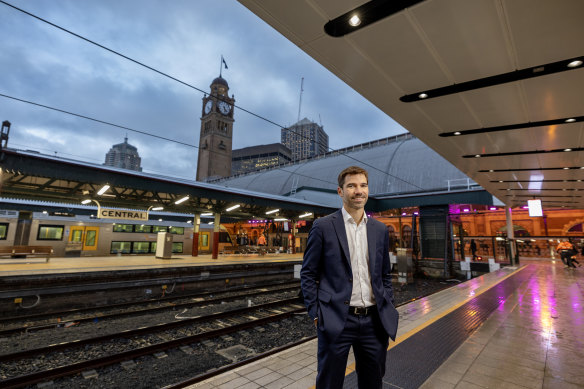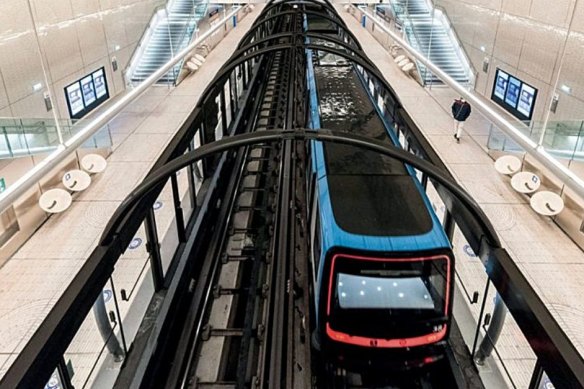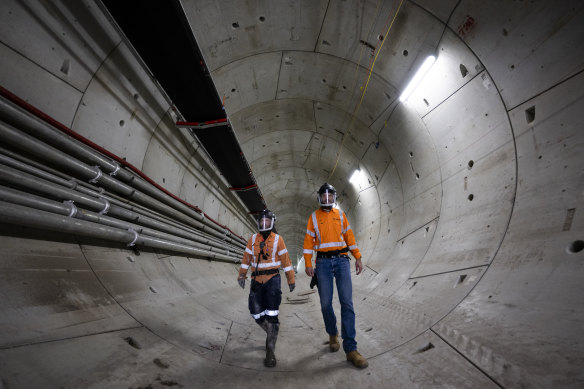This was published 1 year ago
He ran Europe’s second-busiest rail line. Now he’ll oversee one of Sydney’s
Sydney rail officials sweated over their train system’s ability to cope during the 2000 Olympics, knowing that one serious incident could bring everything to a screeching halt and disrupt hundreds of thousands.
Yet, it did cope, and the running of the transport system became one of the Sydney Olympics’ triumphs.
As thousands of Australians flock to Paris for the 2024 Olympics, the host city will hold its breath over its own network’s ability to handle the influx.

Denis Masure, the managing director of RATP Dev in Australia, at Sydney’s Central Station. Credit: Dylan Coker
The man who ran Europe’s second-busiest commuter rail line for four years knows how it feels, and the pressure on the state-owned metro rail operator RATP just days before the Olympics officially start in Paris on Friday.
Denis Masure, who is now the general manager of RATP’s international arm in Australia, said one of the greatest challenges had been ensuring adequate staffing levels during a period when Parisians traditionally left the city for summer holidays.
“What made it complicated is we need to put all the transport patterns to full speed instead of the very reduced [train frequencies] during summer,” he said.
Masure said Paris’ public transport network was accustomed to hosting large festivals, citing last year’s rugby world cup, although hosting the world’s biggest sporting event over the next two weeks was more complicated to manage because scores of events would be happening at once.
“I would lie if I was telling you there is no nervousness, but everything has been put in place,” he said. “We are fairly confident in our capacity to manage the day-to-day.”
Up to 1.5 million extra passengers are forecast to use Paris’ public transport network on some days during the Olympics, representing a 15 per cent increase in weekday patronage.
Weeks before Sydney was due to open a metro rail under the heart of the city, the ribbon was cut on a 16-kilometre extension of a key metro line in Paris on June 24, helping ease pressure on the transit system during the Olympics.
The north-south extension of Line 14 is the first part of a €35 billion ($57.4 billion) rail expansion project dubbed Grand Paris Express, which will comprise 200 kilometres of extra track and 68 new stations.

Extensions to Paris’ Line 14 opened in late June, a month before the Olympics start.
In Sydney, RATP’s international arm will operate driverless trains on a new 23-kilometre metro line to Western Sydney Airport when it opens in late 2026. It is also bidding for major contracts on the city’s $25 billion Metro West rail project and Melbourne’s Suburban Rail Loop.
Before taking the reins in Australia almost five years ago, Masure was head of operations for Paris’ commuter Line B, which had a patronage of a million passengers a day – about the number of trips on Sydney’s entire rail network.
“It’s a challenge every day to welcome 1 million passengers,” he mused.

Workers in the new $11 billion metro rail line to Western Sydney Airport.Credit: Janie Barrett
“Metro is a bit like underground with small stops every 500 metres – the metro network is very dense. It’s part of the DNA of Paris.”
The Olympics are Paris’s biggest event, easily surpassing the Football World Cup in 1998. To manage the influx, organisers are urging everyone to travel by public transport to the events.
“They do not want any cars on the road to access the venues. There is no park space for cars unless ministers and VIPs,” Masure said.
In contrast to Europe, it is common in Australia for spectators to drive to stadiums. Masure, who does not own a car, was surprised at the “massive” car parking areas around Sydney’s Accor Stadium at Olympic Park when he first visited. “Any time there is a big event in Stade de France [in Paris], for instance, I would say 95 per cent of people go by public transport,” he said.
With the NSW Labor government pushing to increase density around train stations, Masure said the key difference between Paris and Sydney was the greater distances people had to travel to get to train stations here due to the relatively low density for a global city.
“There is no miracle. If you want to be close to a train station at some point, it needs to go with a more dense city. And I guess that’s what the Labor government is trying to achieve,” he said.
Start the day with a summary of the day’s most important and interesting stories, analysis and insights. Sign up for our Morning Edition newsletter.